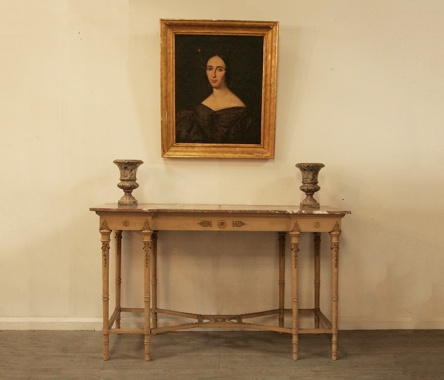Console Yourself
Console Yourself
I can remember no examples of resplendent gilt-wood consoles from my New Zealand childhood - the decorative console is not a fundamental ingredient of the kiwi furnishing vernacular it seems. I imagine it was considered superfluous and ostentatious somehow and simply didn’t gel with the egalitarian grit that commonly pervaded the colonial home. It wasn’t until I traveled to Europe in my youth that I was introduced to the elegance of the console table.
Trying eagerly to absorb European culture by osmosis my partner and I visited numerous stately homes and noble residences where I was enthralled by the glamour and beauty of the ubiquitous console table. The shadowy recesses of an English manor unveiled an exquisite Robert Adam console, abandoned by history as throngs of tourists filed past failing to notice it’s magnificence. I was transfixed. The royal apartments of French chateaux revealed an astonishing procession of consoles, waiting patiently against the walls as the centuries seeped by, the corners sometimes scuffed and the gilt slightly chipped as the everyday movements of generations left their mark and the swags of rose-red satin ropes that forbade proximity to these precious tables prevented us from doing the same. The late 17th century and 18th century were the glory days of the console and every notable interior was furnished abundantly with these fabulous tables - their role was decorative and they were the hallmark of affluence, good taste and social standing.
The console exists in many different styles ranging from the lavish scrolls and foliate carving of the baroque to the minimal aesthetic of modernism and it is not exclusively the domain of affluent households. The purity of a simple wooden console or side table is as dignified as the furniture of kings. The rustic console is functional - it exists as a place to store or display things and was often created to address spacial limitations. A 19th century wooden side table would hold serving platters when space was tight and the dining table too small. A rugged oak console might be the receptacle for game birds after a hunt or hold prayer books in the vestibule of a monastery. The console is not purely decorative but is in fact very useful.
Today the console table is just as much at home in a modern interior as it was in the parquet floored enfilade of an 18th century palace and modern life has a knack of making every console functional which is a pleasing adaptation. One of my best loved consoles is a grand, 19th century console in the baroque style, possibly of Italian provenance, with an enchanting original painted finish - faded storm blue and dusty like the wings of a moth. The fluid lines of the marble follow the shape of the base like the foam tinged edges of a wave arriving on the beach and the exuberant flourishes of the carving echo the sweeping gestures of a conductor in front of a symphony orchestra. The console should be on a stage but it is in the busy and breezy living room of our favourite chambre d’hôte in the Luberon. It is the room you walk through to access the stone terrace shaded by plane trees where breakfast is waiting. It is on this table that you leave the key to your room. A laptop casually balances on a pile of magazines at one end and it is crammed with books, office ephemera and family photographs. It sits modestly there in all it’s unassuming glory, it is well used and it feels just right.

